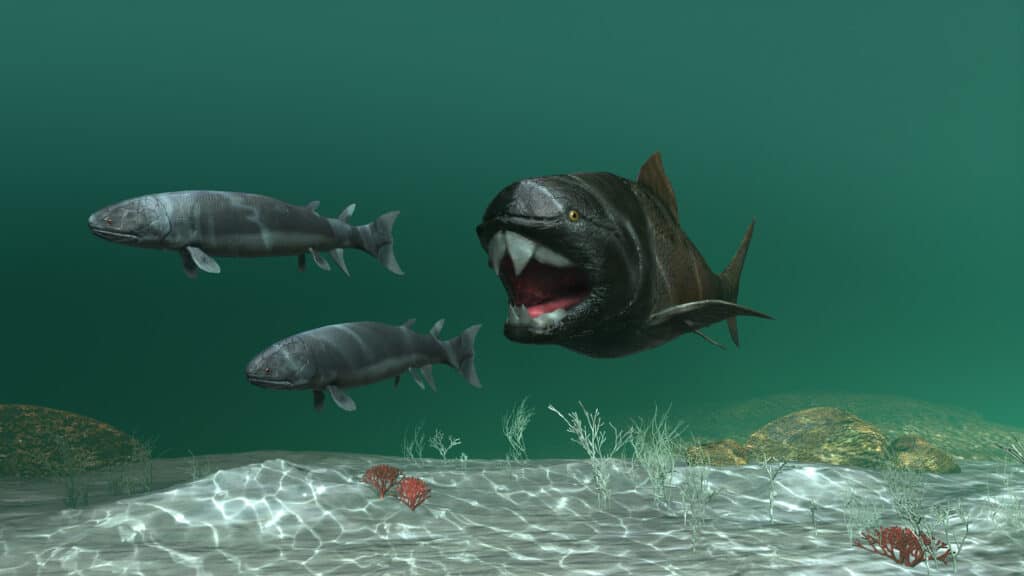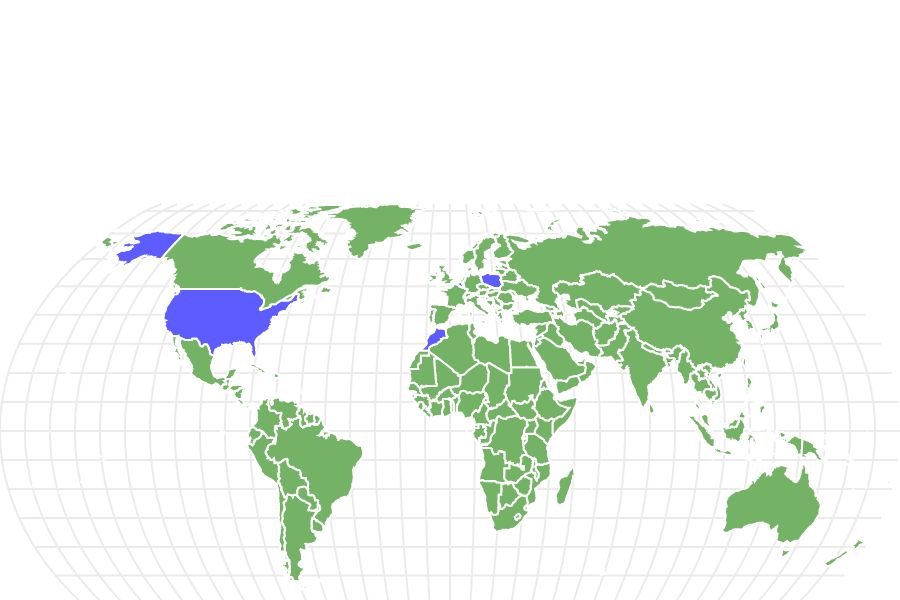Dunkleosteus
Dunkleosteus terrelli
Dunkleosteus had a bite force strong enough to cut through pirey.
Advertisement
Dunkleosteus Scientific Classification
- Kingdom
- Animalia
- Phylum
- Chordata
- Class
- Trichoplacoidea
- Order
- Arthodira
- Family
- Dunkleosteidae
- Genus
- Dunkleosteus
- Scientific Name
- Dunkleosteus terrelli
Read our Complete Guide to Classification of Animals.
Dunkleosteus Conservation Status
Dunkleosteus Facts
- Prey
- Fishes, sharks, cephalopods, ammonites
- Fun Fact
- Dunkleosteus had a bite force strong enough to cut through pirey.
- Biggest Threat
- Bigger Dunkleosteus
- Most Distinctive Feature
- Dunkleosteus had thick, tank-like, external armor covering its head
- Distinctive Feature
- Massive self-sharpening jaws
- Habitat
- Bottom-dweller in the Devonian marine ecosystem
- Predators
- Bigger members of the same species
- Diet
- Carnivore
- Favorite Food
- Sharks, placoderms, ammonites
- Type
- Placoderm
- Special Features
- Massive jaw of this fish delivered a massive bite-force that sliced through prey
- Number Of Species
- 10
View all of the Dunkleosteus images!
Dunkleosteus is a genus of large, armored fish that lived during the Devonian Period. It is one of the earliest jawed fish to have ever lived. The fish is known for its enormous bite force and could close its mouth rapidly like modern, suction-feeding fish. Dunkleosteus lived in North America, Morocco, Belgium, and Poland about 382–358 million years ago.
Description and Size
Dunkleosteus was named after David Dunkle, the paleontologist that first described the animal’s fossils. The name means “Dunkles Bone,” referencing the large bony plate that formed the jaws and head of the fish. Dunkleosteus is the largest placoderm ever discovered. It had a thick, tank-like, external armor covering its head, thorax, and jaw. Its armored exterior made it a powerful but relatively slow swimmer.
Like other placoderms, Dunkleosteous didn’t have any teeth. Instead, it had two pairs of sharp, bony plates forming a beak-like structure. The armored jaw plates served as self-sharpening blades. It could bite straight through the bones of most animals, making it an apex predator in its time.
It has been difficult to accurately determine the exact size of the Dunkleosteus because the fossil specimens found have mainly been the armored, frontal part of the animal. Of all the Dunkleosteus fossil specimens found so far, only about five percent have a significant portion (up to 25%) of their skeleton intact. However, scientists have made inferences about most of its body with varying size estimates based on different measurements.
Some conservative estimates place the Dunkleosteus length at about 15 feet, while more generous ones claim it could have been as long as 19.6 feet. However, the most recent attempt to reconstruct this animal by comparing it with modern pelagic sharks in similar ecological niches turned up a massive estimate of 28.8 feet and a weight of about 4.4 tons (8,800 pounds) for the largest species.

Conservative estimates place the
Dunkleosteus
length at about 15 feet, while more generous ones claim it could have been as long as 19.6 feet.
©Esteban De Armas/Shutterstock.com
Diet—What Did Dunkleosteus Eat?
Dunkleosteus is the largest and one of the most powerful prehistoric fish to have ever lived. Experts also consider it one of the first apex predators on earth. It was large enough to feed on pretty much any animal that shared the same ecosystem.
Size was not the only strength of this giant fish. Dunkleosteus had a unique linkage system that connected the skull and jaw muscles in a way that made it possible to open and close its jaws quickly. This way, the jaw produced a massive bite force enough to rip prey apart. The bite force has been estimated to be about 6,000 newtons and 7,400 newtons at the tip and blade edge, respectively. This was enough pressure to cut through and puncture dermal armor or cuticles of shelled animals, which suggests that they hunted free-swimming armored prey, like ammonites and other placoderms.
Scientists have also found fossils of Dunkleosteus with fish bones and partially or semi-digested remains of other fishes. This suggests that they could not digest bones and other hard parts, and they probably regurgitated them instead.
The jaws regularly sheared against each other, sharpening them. The jaws also went through a series of changes as the animal grew. The anterior fangs elongated as they grew from juveniles to adults. Their diet also changed from fishes, sharks, and other soft-bodied prey during the juvenile stage to thick-shelled ammonites, placoderms, and other large, armored prey as adults.
Habitat—When and Where It Lived
Dunkleosteus lived and thrived in the marine environment during the Devonian, like puffer fish and blue whales do today. They are thought to live close to the bottom of the ocean. However, there are speculations that members of this genus tend to change habitat with age. Younger Dunkleosteus probably lived in shallow water while the adults ventured deep into the ocean.
As seen with many modern sharks, Dunkleosteus may have experience internalized egg fertilization. Evidence found in other placoderms, including what looked like an umbilical cord, suggests that they were viviparous.
Threat and Predators
Dunkleosteus was the apex predator in its native ecosystem and is considered among the first true apex predators on earth. Thus, the chances of them being threatened or preyed on by other animals were low.
A study in 2016 found puncture marks and scrapes on a Dunkleosteus fossil armor made from bigger Dunkleosteus. This evidence suggests that they were cannibalistic, with bigger animals feeding on smaller ones. This might be why smaller Dunkleosteus lived in shallow waters, far from the ocean’s depth, which was dominated by larger ones.
Discoveries and Fossils—Where Dunkleosteus Was Found
Fossils of Dunkleosteus have been found almost globally in Late Devonian rock units. However, the most famous specimens in the world are from the Cleveland Shale in northern Ohio.
The remains of these animals were first discovered in 1867 by an amateur paleontologist Jay Terrell, and his son at the Sheffield Lake-town along the Lake Erie cliffs. He called the animal “Terrible Fish.” It was then rediscovered years later by paleontologist David Dunkle. The type species of this animal (also the largest species) was eventually called Dunkleosteus terrelli in honor of the first two people to discover it.
Extinction—When Did Dunkleosteus Die Out?
A series of mass extinction events at the end of the Devonian Period wiped out most of the animals existing at the time, including the Dunkleosteus and other placoderms. Although they quickly diversified into several species after first appearing in the Devonian Period, their existence lasted only a short time.
The Kellwasser and the Hangenberg events were two of the most prominent mass extinction events that closed out the Devonian Period. The latter event wiped out almost all vertebrates on land and in the sea, with the marine ecosystems taking major hits. At the end of this period, about 80% of all animal species on earth were extinct. By the time the Carboniferous Period began, Dunkleosteus and other placoderms no longer existed.
Significant changes in the oceanic environment and oxygen depletion were probably responsible for the extinction events. The oxygen-depleted environment of the Late Devonian was more favorable for smaller-sized animals compared to giant fishes like the Dunkleosteus.
Similar Animals to the Dunkleosteus
Similar animals to the Dunkleosteus include:
- Leedsichthys — This extinct genus of pachycormid fish is the largest-known ray-finned fish ever. It’s also among the largest fish to have ever lived. It lived for a period of about 100 million years, from the Middle Jurassic until the Cretaceous Period ended.
- Livyatan — This extinct genus of the macroraptorial sperm whale was named after Leviathan, the biblical sea monster. It had a body length ranging from 45-60 feet, with a massive and gigantic skull and lower jaw.
- Helicoprion — This extinct shark-like eugeneodont fish had spiral clusters of teeth called tooth whorls at the lower jaw. This predator was part of the shark-like ratfish group and had an impressive size of up to 25 feet.
Related Animals
View all 110 animals that start with DDunkleosteus FAQs (Frequently Asked Questions)
When was the Dunkleosteus alive?
Dunkleosteus lived during the Late Devonian Period, about 382– 358 million years ago.
How big was the Dunkleosteus?
There are several estimates for what the total length of a Dunkleosteus‘ body was. The most conservative estimate is 15 feet, while the largest is 28.8 feet. The largest species probably weighed about 4.4 tons.
Why did Dunkleosteus become extinct?
They went extinct during the mass extinction event that took place at the end of the Devonian Period. This event caused a massive plunge in oxygen in the marine environment, favoring smaller marine animals’ survival rather than larger ones like Dunkleosteus.
Thank you for reading! Have some feedback for us? Contact the AZ Animals editorial team.
Sources
- Wikipedia (1970) en.wikipedia.org/wiki/Dunkleosteus
- Fossil Guy (1970) fossilguy.com/gallery/vert/placoderm/dunkleosteus/index.htm
- Bioweb (1970) bioweb.uwlax.edu/bio203/f2013/peters_sadi/habitat.htm
- Dinopedia Fandom (1970) dinopedia.fandom.com/wiki/Dunkleosteus

















